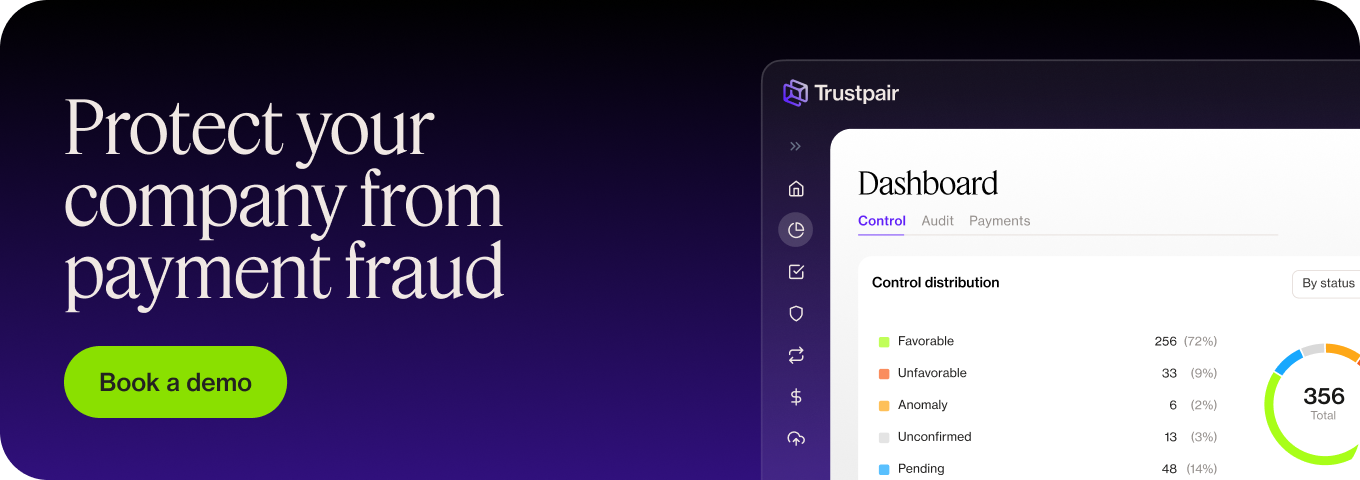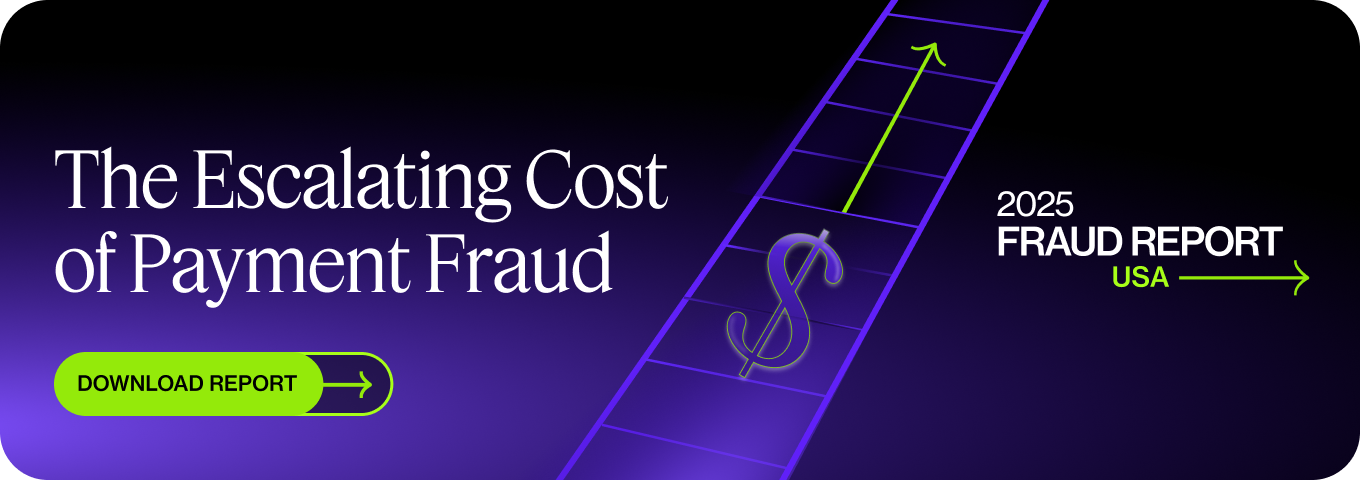Can you imagine losing $46M to fraudsters over a year? Ubiquity Networks, a U.S. company, didn’t. Yet in 2015, the organization lost funds through wire fraud. If you don’t want this to happen to your organization, keep reading to find out what exactly wire fraud is and how to protect yourself effectively against it.
Trustpair blocks the financial effects of wire fraud by continuously controlling payments before they’re executed. Contact an expert to learn more!
What is wire fraud?
Wire fraud has been around for as long as the Internet has existed — if not before. At its core, wire fraud is very similar to mail fraud, a federal offense.
But it’s undeniable that the development of the Internet has made these types of financial crimes easier to carry, and therefore more dangerous. Wire fraud is now one of the most popular internet frauds.
It occurs when someone tries defrauding a person or organization through electronic communications, such as emails or text messages.
Fraudsters use false pretenses to get you or your employees to wire money to their bank accounts. Once you discover the fraud, hackers are usually long gone, and the money is irretrievable.
In the U.S., wire fraud is considered a criminal offense under federal law. Wire fraud can be carried out interstate or even internationally.
It’s not uncommon to have fraudsters contact US companies from overseas — in scams more elaborate than the “Nigerian prince” one.
It’s especially hard to keep track of what’s legitimate and what’s a fraudulent attempt when you work with overseas suppliers. This is why Trustpair is a great way to protect yourself, but we’ll talk more about us later.
What are the elements of wire fraud?
Signs of wire fraud
Wire fraud has many faces, and we’ll see different examples of it later. But all wire scams have one element in common: using false pretenses.
Fraudsters will contact you under the disguise of being a supplier, a client, a federal government officer, or even a United States attorney… the list is endless.
They do that either by committing identity theft or spoofing. In the former, they hack into a real contact’s email and pretend to be them. It’s nearly impossible to detect.
In the latter, they replicate a legitimate email address or website that’s almost identical: using john@gooogle.com (3 letter O) for instance, or redirecting you to a bogus website in a pharming attack.
In reality, you’ll be revealing financial information or sending funds to a scammer who’ll disappear when (if) the fraud is revealed.
They can also use phishing, or other social engineering techniques to steal sensitive information.
Elements to prosecute for wire fraud
In legal terms, wire fraud is committed when several elements are gathered. The prosecution has to prove the defendants:
- Acted under false pretenses to defraud someone of money or property or another asset.
- Did so knowingly, or intentionally to defraud.
- Made false representations.
- Sent electronic communications with misrepresentation interstate or internationally.
The prosecution must prove those beyond a reasonable doubt to obtain a conviction on the charge of wire fraud.
Because wire fraud requires some elaborate scheming in the corporate world, it falls under the category of white-collar crime — just like embezzlement or money laundering.
What are examples of wire fraud?
Personal vs corporate fraud
When fraudsters target individuals, wire fraud can take various forms:
- Credit card fraud,
- Mortgage fraud,
- Healthcare fraud or medicare fraud,
- Insurance fraud,
- Etc.
When it comes to B2B payment fraud, there are also various types of fraud to watch out for. One of the most common corporate fraud schemes is called Business Email Compromise (BEC), which leads to wire transfer fraud.
In BEC, the perpetrator impersonates someone your company has an established relationship with (like a client, a supplier, or a financial institution) and uses high-pressure tactics to get you to commit a dangerous action, such as:
- Revealing your business bank account number,
- Sending personal information that’ll be used to log in to your software,
- Transferring money to a new bank account.
The last one is what is called wire transfer fraud. The two first examples can lead to wire fraud, as this information will be used to build a scam.
Here are a few examples of what corporate wire fraud looks like:
CEO fraud
In CEO fraud, fraudsters contact an employee by email impersonating their CEO, or another high-level executive.
They’ll often ask for an “urgent” transfer to be made to a supplier — they’ll make up excuses like the invoice is late, or the transfer is needed to finalize a strategic deal.
The employee targeted wires the money, thinking they’re safeguarding their jobs and pleasing their boss. What they’re really doing is wiring money to an unknown account that’ll likely be closed within a few hours.
CEO fraud and whaling attacks are unfortunately quite common. They require extensive preparation but have high potential payoffs.
Vendor fraud
Another scheme that leads to wire fraud is vendor fraud. Here, scammers pretend to be one of your suppliers by email and ask for the funds to be transferred to a different account. They’ll pretend there is an audit, or that they closed the previous one.
Without precautionary measures, an employee will change the information — not knowing it’s actually switching your real supplier’s credentials for fake ones.
When your finance or accounting team pays the next invoice, however, it’s not your supplier who will receive it, but the scammers. That can lead to difficult supplier management on top of the money lost.
Learn all there is to know about payment fraud and how to fight it in your business in our latest fraud report!
How can you safeguard your business against fraud?
Before having to hire a fraud lawyer, consider implementing these prevention policies:
Improve your security
To effectively protect yourself, security should be a company-wide priority. You can do so by:
- Providing regular and ongoing security awareness training that includes real-life examples of social engineering fraud, and the latest scams.
- Being cautious of opening emails from unknown recipients, especially if they have too good to be true offers — they’re likely phishing emails that’ll install malware or spyware on your network.
- Using multi-authentication factors to log in to your software.
Establish clear payment processes
Cybercriminals take advantage of the lack of clarity of big corporations to commit fraud. To counteract this, you need to have clear processes relating to payments:
- Establish a clear payment process with a traceable trail. You can for instance set up various authorization processes for different amounts of funds transfers.
- Adopt concepts like the segregation of duties, that ensures no one employee has full responsibility over one process (like procurement).
- Encourage employees to use the 4 eyes principle to increase protection, requiring two people to authorize a transaction that looks suspicious.
Use anti-fraud software
To protect yourself efficiently against the effects of wire fraud — especially BEC types — you need anti-fraud software. Paired with the safety measures above, they’ll help you block any unauthorized transaction, ensuring you don’t fall victim to wire fraud.
Trustpair completely eradicates the risk of third-party fraud by automatically checking your supplier’s credentials every time a transaction is about to be sent.
We use 3-way matching to ensure you’re sending your funds to the correct account, by checking:
- The bank account exists,
- The name is a real one,
- Both pieces of information match.
Our solution detects fraudulently-looking transactions before they’re sent and raises the alert. We do this continuously and in real-time, so you can be sure you’re always sending the funds to the right person. Contact an expert to learn more!
Key Takeaways:
- Wire fraud happens when fraudsters contact you under false pretenses to steal data or money from your organization, via electronic means (email, text message, etc).
- To protect yourself effectively against it, and especially against B2B fraud, you need an anti-fraud software solution like Trustpair.






